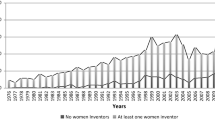Abstract
The involvement of male and female scientists in the technological activity developed in Spain is analysed through the study of patent applications filed with the Spanish OEPM database during the period 1990–2005. Comparative analyses based on participation, contribution and inventors by gender are presented and discussed. The study reveals a low female involvement in technology, which tends to concentrate in specific institutional sectors (public research institutions) and technological sections (A/Human Necessities and C/Chemistry). Over the 16-year period analysed the involvement of female scientists rose at a higher rate than that of men in most of the institutional sectors and technological fields. The highest relative increase corresponds to University and Spanish National Research Council, and our data suggest that it is enhanced by collaboration. To make the production of sex-disaggregated technology indicators easier the inclusion of the sex of the inventors as an additional field in patent databases would be desirable, as well as a higher normalisation of inventor names, applicant names (full names) and institutional affiliations.








Similar content being viewed by others
References
Archibugi, D. (1992). Patenting as an indicator of technological innovation: A review. Science and Public Policy, 19(6), 357–367.
Azoulay, P., Ding, W., & Stuart, T. (2007). The determinants of faculty patenting behavior: Demographics or opportunities? Journal of Economic Behaviour & Organization, 63, 599–623.
Balconi, M., Breschi, S., & Lissoni, F. (2004). Networks of inventors and the role of academia: An exploration of Italian patent data. Research Policy, 33(1), 127–145.
Bordons, M., Mauleón, E., Gómez Caridad, I., Morillo, F., Sancho, R., Fernández, M. T., et al. (2008). Indicadores de actividad tecnológica desagregados por sexo. Research Project Instituto de la Mujer (Exp 67/05). Madrid: IEDCYT-CCHS, CSIC.
Breschi, S., & Lissoni, F. (2007). Cross-firms inventors and social networks: Localised knowledge spillovers revisited. Annales d’Economie et de Statis-tique (forthcoming).
Breschi, S., Lissoni, F., & Montobbio, F. (2007). The scientific productivity of academic inventors: New evidence from Italian data. Economics of Innovation and New Technology, 16(2), 101–108.
Costas, R., & Bordons, M. (2007). Algoritmos para solventar la falta de normalización de nombres de autor en los estudios bibliométricos. Investigación Bibliotecológica: archivonomía, bibliotecología e información, 21(42), 13–32.
Ding, W. W., Murray, F., & Stuart, T. E. (2006). Gender differences in patenting in the academic life sciences. Science, 313(5787), 665–667.
Fernández, M. T., Cabrero, A., Zulueta, M. A., & Gómez, I. (1993). Constructing a relational database for bibliometric analysis. Research Evaluation, 3(1), 55–62.
Frietsch, R., Haller, I., Funken-Vrohlings, M., & Grupp, H. (2009). Gender-specific patterns in patenting and publishing. Research Policy, 38(4), 590–599.
Giuri, P., & Mariani, M. (2007). Editorial. Inventors and invention processes in Europe. Results from the PatVal-EU survey. Research Policy, 36(8), 1105–1106.
Glanzel, W., & Schubert, A. (2004). Analysing scientific networks through co-authorship. In H. F. Moed, W. Glanzel, & U. Schmoch (Eds.), Handbook of quantitative science and technology research: The use of publication and patent statistics in studies of S&T systems (pp. 257–276). Dordrecht: Kluwer Academic Publishers.
INE. (2009). Instituto Nacional de Estadística. www.ine.es.
Long, J. S. (1990). The origins of sex differences in science. Social Forces, 68(4), 1297–1315.
Mauleon, E., & Bordons, M. (2006). Productivity, impact and publication habits by gender in the area of Materials Science. Scientometrics, 66(1), 199–218.
Morgan, R. P., Kruytbosch, C., & Kannankutty, N. (2001). Patenting and invention activity of US scientists and engineers in the academic sector: Comparisons with industry. Journal of Technology Transfer, 26, 173–183.
Moya-Anegón, F., Chinchilla Rodríguez, Z., Corera-Álvarez, E., González-Molina, A., Hassan Montero, Y., & Vargas-Quesada, B. (2008). Indicadores bibliométricos de la actividad científica española 2002–2006. Madrid: FECYT.
Naldi, F., Luzi, D., Valente, A., & Vannini, P. (2004). Scientific and technological performance by gender. In H. F. Moed, W. Glänzel, & U. Schmoch (Eds.), Handbook of quantitative science and technology research. The use of publication and patent statistics in studies of S&T systems (pp. 299–314). Dordrecht: Kluwer Academic Publishers.
Narin, F. (1994). Patent bibliometrics. Scientometrics, 30(1), 147–155.
National Science Foundation. (2007). Women, minorities, and persons with disabilities in science and engineering: 2007, NSF 07-315, Arlington, VA: NSF.
Nesta, P., & Patel, P. (2004). National patterns of technology accumulation: Use of patent statistics. In H. F. Moed, W. Glanzel, & U. Schmoch (Eds.), Handbook of quantitative science and technology research: The use of publication and patent statistics in studies of S&T systems (pp. 531–551). Dordrecht: Kluwer Academic Publishers.
OECD. (1994). The measurement of scientific and technological activities. Using patent data as science and technology indicators. Patent Manual 1994. Paris: OECD/GD(94)114.
Ogawa, M. (2005). Women’s careers in science and technology in Japan. In: Women in Scientific Careers: Unleashing the Potential, (pp 87–94). Paris: OECD.
Prpic, K. (2002). Gender and productivity differentials in science. Scientometrics, 55(1), 27–58.
Ruíz Pérez, R., Delgado López-Cózar, D., & Jiménez Contreras, E. (2002). Spanish personal name variations in national and international biomedical databases: Implications for information retrieval and bibliometric studies. Journal of Medical Library Association, 90(4), 411–430.
Schild, I. (1999). A regional patent study to investigate inventive activity in East Gothia. University of Linkoping Working Paper No: 207.
She Figures. (2006). Women in science: Statistics and indicators. European Commission. Directorate-General for Research, Directorate C-Science and Society, Unit C.4-Women and Science. Brussels. http://kif.nbi.dk/She_Figures_2006.pdf.
Whittington, K. B., & Smith-Doerr, L. (2005). Gender and commercial science: Women′s patenting in the Life Sciences. Journal of Technology Transfer, 30, 355–370.
Whittington, K. B., & Smith-Doerr, L. (2008). Women inventors in context. Disparities in patenting across academia and industry. Gender and Society, 22(2), 194–218.
Acknowledgements
This study was supported by a FPU grant (AP2003-1361) from the Spanish Education Ministry, as well as by the Spanish Labour and Social Affairs Ministry (Research project I+D+I 87/02).
Author information
Authors and Affiliations
Corresponding author
Rights and permissions
About this article
Cite this article
Mauleón, E., Bordons, M. Male and female involvement in patenting activity in Spain. Scientometrics 83, 605–621 (2010). https://doi.org/10.1007/s11192-009-0131-x
Received:
Published:
Issue Date:
DOI: https://doi.org/10.1007/s11192-009-0131-x




